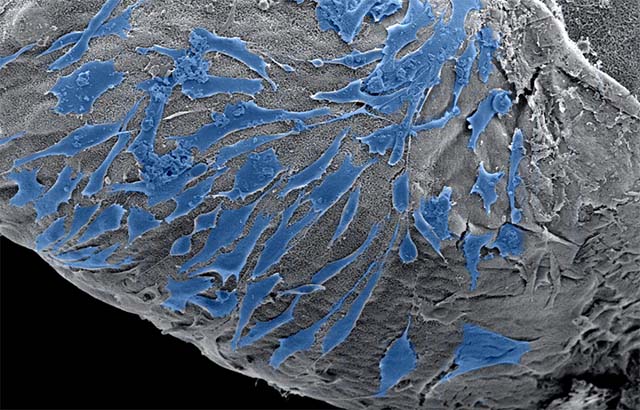New printing technique uses cells and molecules to recreate biological structures
Researchers from Queen Mary University of London have developed a printing technique using cells and molecules normally found in natural tissues to create constructs that resemble biological structures.

Cells spreading on the outside of a scaffold
These structures are embedded in an ink which is similar to their native environment and opens the possibility to make them behave as they would in the body.
This allows the researchers to observe how cells work within these environments and potentially enables them to study biological scenarios such as where cancer grows or how immune cells interact with other cells, which could lead to the development of new drugs.
The technique combines molecular self-assembly, building structures by assembling molecules like Lego pieces, with additive manufacturing, similar to 3D printing, to recreate the complex structures.
The structures can be manufactured under digital control and with molecular precision which also enables the researchers to create constructs that mimic body parts or tissues for tissue engineering or regenerative medicine.
The study is published in Advanced Functional Materials.
Professor Alvaro Mata, from Queen Mary’s School of Engineering and Materials Science, said: “The technique opens the possibility to design and create biological scenarios like complex and specific cell environments, which can be used in different fields such as tissue engineering by creating constructs that resemble tissues or in vitro models that can be used to test drugs in a more efficient manner.”
Integrating control
The technique integrates the micro- and macroscopic control of structural features that printing provides with the molecular and nano-scale control enabled by self-assembly. Because of this, it addresses a major need in 3D printing where commonly used printing inks have limited capacity to actively stimulate the cells that are being printed.
PhD student Clara Hedegaard, leading author of the paper, added: “This method enables the possibility to build 3D structures by printing multiple types of biomolecules capable of assembling into well defined structures at multiple scales. Because of this, the self-assembling ink provides an opportunity to control the chemical and physical properties during and after printing, which can be tuned to stimulate cell behaviour.”
The study was carried out in collaboration with the Nanyang Technological University in Singapore and the University of Oxford.
It was supported by the European Research Council’s Starting Grant (STROFUNSCAFF), the FP7-PEOPLE-2013-CIG Biomorph, the Royal Society, and the European Space Agency’s Drop My Thesis program 2016.
More information:
- Research paper: ‘Hydrodynamically guided hierarchical self-assembly of peptide-protein bioinks’. Clara L. Hedegaard, Estelle C. Collin, Carlos Redondo-Gomez, Luong T. H. Nguyen, Kee Woei Ng, Alfonso A. Castrejón-Pita, J. Rafael Castrejón-Pita and Alvaro Mata. Advanced Functional Materials.
- Find out more about Biomedical Engineering with Biomaterials and Tissue Engineering at Queen Mary
Related items

9 December 2024

28 November 2024
